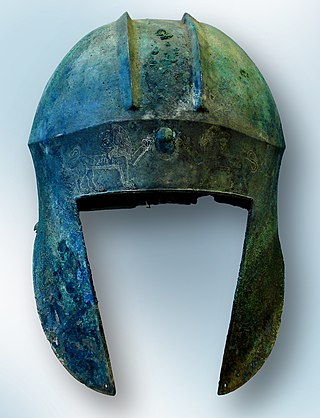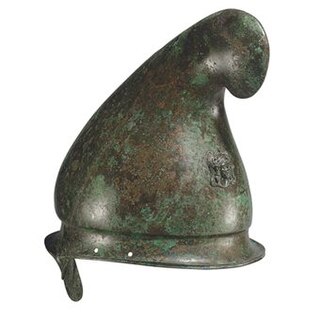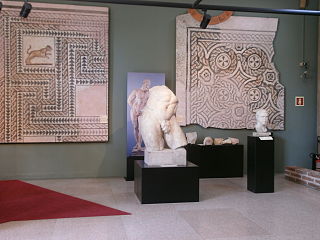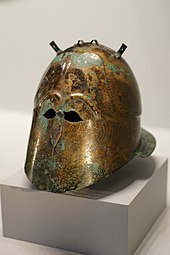
The Phrygian cap, also known as Thracian cap and liberty cap, is a soft conical cap with the apex bent over, associated in antiquity with several peoples in Eastern Europe, Anatolia, and Asia. The Phrygian cap was worn by Thracians, Dacians, Persians, Medes, Scythians, Trojans, Amazons, and Phrygians after whom it is named. The oldest known depiction of the Phrygian cap is from Persepolis in Iran.

A peltast was a type of light infantry originating in Thrace and Paeonia and named after the kind of shield he carried. Thucydides mentions the Thracian peltasts, while Xenophon in the Anabasis distinguishes the Thracian and Greek peltast troops.

Tanit or Tinnit was a chief deity of Ancient Carthage; she derives from a local Berber deity and the consort of Baal Hammon. As Ammon is a local Libyan deity, so is Tannit, which she represents the matriarchal aspect of Numidian society, whom the Egyptians identify as Neith and the Greeks identify as Athena. She was the goddess of Wisdom, civilization and the crafts; she is the defender of towns and homes where she is worshipped. Ancient North Africans used to put her sign on tombstones and homes to ask for protection, her main temples in Thinissut, Cirta, Lambaesis and Theveste. She had a yearly festival in Antiquity which persists to this day in many parts of North Africa but was banned by Muammar Gaddafi in Libya, who called it a pagan festival.

A bust is a sculpted or cast representation of the upper part of the human body, depicting a person's head and neck, and a variable portion of the chest and shoulders. The piece is normally supported by a plinth. The bust is generally a portrait intended to record the appearance of an individual, but may sometimes represent a type. They may be of any medium used for sculpture, such as marble, bronze, terracotta, plaster, wax or wood.

The sculpture of ancient Greece is the main surviving type of fine ancient Greek art as, with the exception of painted ancient Greek pottery, almost no ancient Greek painting survives. Modern scholarship identifies three major stages in monumental sculpture in bronze and stone: the Archaic, Classical and Hellenistic. At all periods there were great numbers of Greek terracotta figurines and small sculptures in metal and other materials.

A chiton is a form of tunic that fastens at the shoulder, worn by men and women of ancient Greece and Rome. There are two forms of chiton: the Doric and the later Ionic. According to Herodotus, popular legend was that Athenian women began to wear the chiton as opposed to the peplos after several women stabbed a messenger to death with the bronze pins characteristic of the peplos.

The Athena Promachos was a colossal bronze statue of Athena sculpted by Pheidias, which stood between the Propylaea and the Parthenon on the Acropolis of Athens. Athena was the tutelary deity of Athens and the goddess of wisdom and warriors. Pheidias also sculpted two other figures of Athena on the Acropolis, the huge gold and ivory ("chryselephantine") cult image of Athena Parthenos in the Parthenon and the Lemnian Athena.

During the Iron Age and Classical antiquity, Libya referred to modern-day Africa west of the Nile river. Greek and Roman geographers placed the dividing line between Libya/Africa and Asia at the Nile. In contrast, the areas of Sub-Saharan Africa were known as Aethiopia. Africa in the broad sense that the Greeks called Libya, i.e. the part of Africa bounded by the Nile, the Mediterranean and the Atlantic was one of the three parts of the world of the ancients.
In Greek mythology, Pallas was a warrior and a daughter of Triton.

The pileus was a brimless felt cap worn in Ancient Greece, Etruria, Illyria, later also introduced in Ancient Rome. The pileus also appears on Apulian red-figure pottery.

The Boeotian helmet was a type of combat helmet used in Ancient Greece and Greek-influenced regions during the classical and Hellenistic periods, as well as in Ancient Rome; it possibly originated in the Greek region of Boeotia.

The Illyrian type helmet is a style of bronze helmet, which in its later variations covered the entire head and neck, and was open-faced in all of its forms. It originated in Peloponnese, ancient Greece, and was developed during the 8th and 7th centuries BC. Accurate representations on Corinthian vases are sufficient to indicate that the Illyrian type helmet was developed before 600 BC. The helmet is named today as Illyrian type for convenience due to many initial archaeological discoveries coming from the region of Illyria.

Corinth was a city-state (polis) on the Isthmus of Corinth, the narrow stretch of land that joins the Peloponnese peninsula to the mainland of Greece, roughly halfway between Athens and Sparta. The modern city of Corinth is located approximately 5 kilometres (3.1 mi) northeast of the ancient ruins. Since 1896, systematic archaeological investigations of the Corinth Excavations by the American School of Classical Studies at Athens have revealed large parts of the ancient city, and recent excavations conducted by the Greek Ministry of Culture have brought to light important new facets of antiquity.

The Attic helmet was a type of helmet that originated in Classical Greece and was widely used in Italy and the Hellenistic world until well into the Roman Empire. Its name is a modern historiographic convention: "Terms such as Illyrian and Attic are used in archaeology for convenience to denote a particular type of helmet and do not imply its origin".

The history of Thracian warfare spans from the 10th century BC up to the 1st century AD in the region defined by Ancient Greek and Latin historians as Thrace. It concerns the armed conflicts of the Thracian tribes and their kingdoms in the Balkans. Apart from conflicts between Thracians and neighboring nations and tribes, numerous wars were recorded among Thracian tribes.

The Phrygian helmet, also known as the Thracian helmet, was a type of helmet that originated in ancient Greece, towards the close of the classical period and was used throughout the Hellenistic world until well into the period of the Roman Republic. Widely used by Greek, Macedonian, Diadochi, Italic peoples, Etruscans, Thracian, Phrygian and Dacian warriors throughout the Hellenistic and Roman republican period and by some ethnicities into Roman imperial times.

Thracian clothing refers to types of clothing worn mainly by Thracians, Dacians but also by some Greeks. Its best literal descriptions are given by Herodotus and Xenophon in his Anabasis. Depictions are found in a great number of Greek vases and there are a few Persian representations as well. In contrast to shapes and patterns we have very little evidence on the colours used.

The Archaeological Museum of Milan is located in the ex-convent of the Monastero Maggiore, alongside the ancient church of San Maurizio al Monastero Maggiore, with entrance on Corso Magenta.

The Piraeus Athena is a Greek bronze statue dated to the fourth century BCE. Named for the city in which it was found, it currently resides in the Archaeological Museum of Piraeus.

Ancient Greek art stands out among that of other ancient cultures for its development of naturalistic but idealized depictions of the human body, in which largely nude male figures were generally the focus of innovation. The rate of stylistic development between about 750 and 300 BC was remarkable by ancient standards, and in surviving works is best seen in sculpture. There were important innovations in painting, which have to be essentially reconstructed due to the lack of original survivals of quality, other than the distinct field of painted pottery.





















